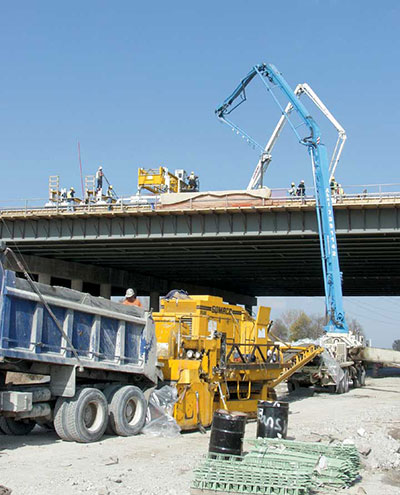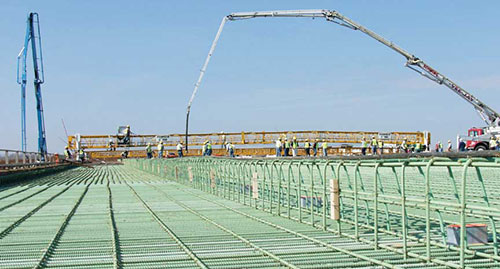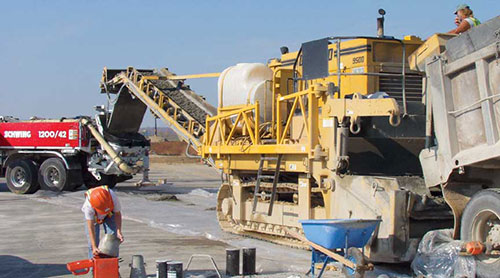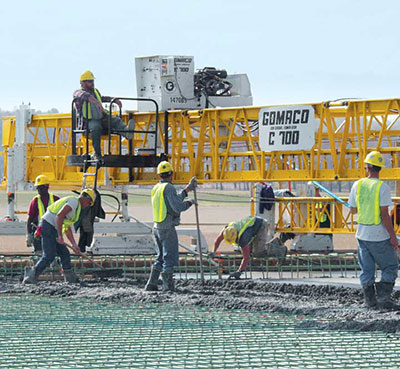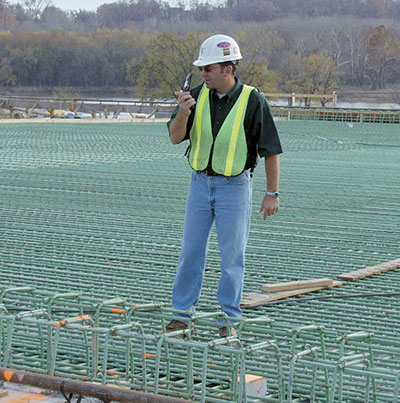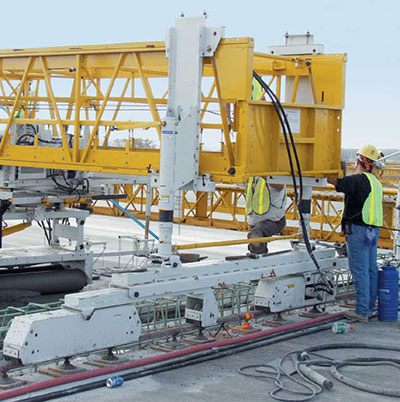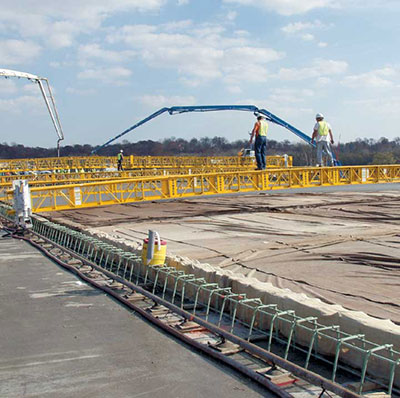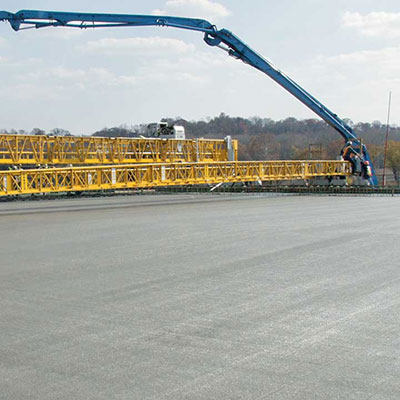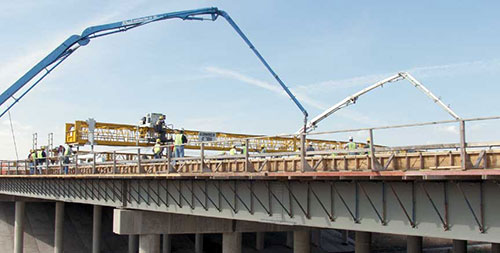GOMACO World Index --- GOMACO World 30.1 - January 2002
109 Foot (33 m) Pour On The First Of Five Bridges In St. Louis County
Work is almost complete on the first of five bridges that Fred Weber, Inc., will construct as part of the Page Avenue extension in St. Louis, Missouri. It will carry five lanes of traffic on both the east and the westbound lanes plus an additional 12 foot (3.66 m) bike path on the south side. A GOMACO C-700 bridge deck finisher is being used to pave all the decks on the $10 million project that will carry traffic from St. Louis County into St. Charles County.
This is not a typical project for Fred Weber. They specialize in concrete paving and bridge work and most of their projects have to be done in stages to maintain traffic flows. The new extension won't be opened to traffic until its July 2002 deadline.
It's also the first chance the company has had to use its new bridge deck finisher, the C-700.
"The toughest part of pouring a bridge deck is getting it ready," Chris Gottman, project manager, said. "The preparation, getting everything set up with manpower and equipment, especially on a deck of this size, really takes a lot of coordination."
Preparations for the pour begin with setting the precast panels first and then constructing the overhang.
"Typically we use a four foot (1.22 m) spacing, but with this wide of a deck at 109 feet (33 m) and the length of the machine, we had to decrease our spacing," Gottman explained. "Our overhang spacing is approximately 38 inches (965 mm) on this bridge."
The bogie wheel system on the C-700 was also modified to help space out the wheel loads.
"GOMACO came up with a bogie wheel system which turned our eight-wheel machine into a 12-wheel machine," Gottman said. "It allowed us to spread the load out over four more additional wheels which also helped us out in our overhang bracket spacing. Had we not done that, the overhang bracket spacing would have to be even tighter than they are."
With precast panels in place and the overhang formed, the steel reinforcing can be tied.
"There's a couple of reasons we use the precast panels. One thing is speed. We can set the panels about twice as fast as we can deck a bridge with the same crew size. It just gets us to the deck pour a lot quicker," Gottman said. "It's also more economical. You've got a lot of labor costs involved with the conventional type of plywood decking."
Sideforms are built on the overhang and the rails are set on the sideforms of the existing deck while the steel reinforcing is being completed. When the reinforcing is close to completion, the C-700 is placed on the rails and prepared for a dry run.
"A day or two before the pour we run the machine from one end of the deck to the other to check our marks, make sure the crown is set right and to make sure we maintain the minimum slab thickness that's allowed," Gottman explained.
With the dry run complete, Fred Weber is ready to pour. Concrete is supplied from their own batch plant and quarry located at their north office complex in St. Louis. At the job site, pumps are needed to place the concrete in front of the C-700 but the hoppers on the pumps aren't large enough to accommodate Fred Weber's tandem-style dump trucks.
They solved that problem by using two GOMACO 9500 concrete placers. Concrete is dumped from the trucks into the 9500's hopper. The belt placers on the 9500s feed the hoppers on the pumps which allow concrete to placed in front of the C-700.
"It works really good," Gottman said. "We try to use our batch plant as much as possible on all our deck pours and 9500 placers help us do that. We've been doing it this way for quite a while and it works really well."
The first of the five bridge decks was poured in two sections. The first side was 85 feet (26 m) wide by 309 feet (94 m) long. The second pour was stretched out to 109 feet (33 m) wide with a 12 foot (3.66 m) bike path on the south side. The deck has a two percent cross slope in each direction from the crown.
The concrete deck is 5.5 inches (140 mm) thick over the three inch (76 mm) thick precast panels.
The concrete is a Missouri Department of Transportation B-2 mix with fly ash and a 2.5 hour retarder. The mix has a 5.5 to 6 percent air content with slump averaging three inches (76 mm).
"Three inches (76 mm) is the maximum allowed," Gottman explained. "We don't like it much dryer than that as far as workability and closing it up on the deck."
Fred Weber's C-700 is equipped with the double-drum undercarriage. It has an automatic advance with preset timing that is electronically controlled at the end of each finishing pass. As the machine advances, a turntable attached to the undercarriage allows it to change the attack angle for every finishing pass.
"The changing attack angle is a nice feature," Gottman said. "As you move forward, it turns in the direction that you're pouring and it windrows the concrete out in front of the machine. It helps out with the finishing process."
Workers use three Spanit® work bridges for the finishing process. The deck has a comb finish applied before it is covered with wet burlap as part of the curing process. With the burlap in place, soaker hoses are run and the deck is wet cured for approximately five days. The burlap is then removed and a linseed-oil finish applied to seal the deck.
Final touches for the bridge deck will be applied later when Fred Weber uses their Commander III to slipform the barrier and parapet walls.
"There's a lot of work involved with a bridge deck pour. You get kind of nervous, especially on a deck this wide," Gottman said. "We're happy with the production and the quality of the product we're getting from our C-700. When we walk away from here, we know we have a really good product."
Subscribe to Receive GOMACO World Magazine
